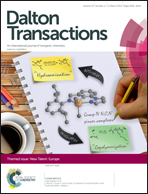Structural rearrangements induced by acid–base reactions in metal carbonyl clusters: the case of [H3−nCo15Pd9C3(CO)38]n− (n = 0–3)†
Abstract
The new bimetallic [HCo15Pd9C3(CO)38]2− tri-carbide carbonyl cluster has been obtained from the reaction of [H2Co20Pd16C4(CO)48]4− with an excess of acid in CH2Cl2 solution. The mono-hydride di-anion can be reversibly protonated and deprotonated by means of acid–base reactions leading to closely related [H3−nCo15Pd9C3(CO)38]n− (n = 0–3) clusters. The crystal structures of the three anionic and the neutral clusters have been determined as their H3Co15Pd9C3(CO)38·2thf, [NEt4][H2Co15Pd9C3(CO)38]·0.5C6H14, [NMe3(CH2Ph)]2[HCo15Pd9C3(CO)38]·C6H14 and [NEt4]3[Co15Pd9C3(CO)38]·thf salts. They are composed of a Pd9(μ3-CO)2 core stabilised by three Co5C(CO)12 organometallic fragments. The poly-hydride nature of these clusters has been indirectly inferred via chemical, electrochemical and magnetic measurements. Besides, cyclic voltammetry shows that the [H3−nCo15Pd9C3(CO)38]n− (n = 1–3) anions are multivalent, since they undergo two or three reversible oxidations. SQUID measurements of [HCo15Pd9C3(CO)38]2− indicate that this even electron cluster is paramagnetic with two unpaired electrons, giving further support to its hydride nature. Finally, structural studies show that the Pd9 core of [H3−nCo15Pd9C3(CO)38]n− (n = 0,1) is a tri-capped octahedron, which becomes a tri-capped trigonal prism in the more charged [H3−nCo15Pd9C3(CO)38]n− (n = 2,3) anions. Such a significant structural rearrangement of the metal core of a large carbonyl cluster upon protonation–deprotonation reactions is unprecedented in cluster chemistry, and suggests that interstitial hydrides may have relevant stereochemical effects even in large carbonyl clusters.
![Graphical abstract: Structural rearrangements induced by acid–base reactions in metal carbonyl clusters: the case of [H3−nCo15Pd9C3(CO)38]n− (n = 0–3)](/en/Image/Get?imageInfo.ImageType=GA&imageInfo.ImageIdentifier.ManuscriptID=C3DT52527A&imageInfo.ImageIdentifier.Year=2014)
- This article is part of the themed collection: New Talent: Europe

 Please wait while we load your content...
Please wait while we load your content...